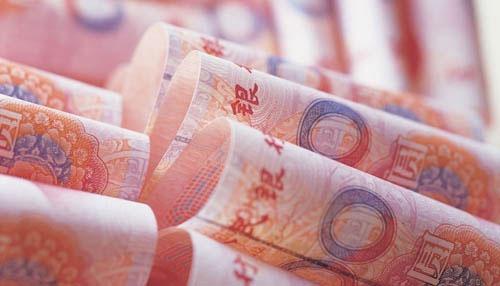
Increasing usage set to surge, a decade into its internationalization
As New China continues to celebrate the 70th anniversary of its founding, the renminbi is having its own moment under the sun, savoring the first decade of its internationalization.
The yuan has much to boast about its performance over the last 10 years, and is set to cement its place among the world's leading currencies in the coming decade, experts said.
As of August, more than 2,200 financial institutions worldwide were said to be using the yuan in their transactions. Data from the International Monetary Fund indicated that by the end of the first quarter of this year, central banks around the world had $212.9 billion in RMB-denominated reserves, accounting for 1.95 percent of all reserves.
According to the People's Bank of China, the central bank, yuan-denominated assets held by foreign institutions and individuals rose more than 65 percent from about 2.9 trillion yuan ($409.2 billion) in 2013 to 4.85 trillion yuan in 2018.
Cross-border flows of yuan-denominated investments rose sharply in the last decade, ever since the RMB was internationalized. Yuan-denominated foreign direct investment in China and China's overseas direct investment rose to 2.66 trillion yuan in 2018 from 28 billion yuan in 2010, up 95 times, PBOC data showed.
And the outstanding value of China's yuan-denominated overseas bonds rose from $895 million in 2007 to $1.08 trillion in 2018, according to data from the Bank for International Settlements.
All this data vindicates China's decision in 2009 to internationalize its currency to ensure the yuan's stature matches the country's economic heft and the humongous scale of its international trade, analysts said.
As an international currency for settlements, invoice trade and store of value, the Chinese yuan has evolved over the last decade, putting behind it the long-troubling trilemma (or "the impossible trinity", which refers to the notion that it is impossible for a country to have a stable currency, an independent monetary policy and the free movement of capital-the absence of capital controls-at the same time).
Chinese monetary authorities have recently set new long-term goals for RMB as an international currency: The yuan should be more widely used in cross-border investments, transactions of financial markets, and central bank reserves.
These points were enunciated by Pan Gongsheng, vice-governor of the PBOC, in an article to mark the 10th anniversary of RMB internationalization earlier this year.
Pan highlighted continual deepening of market-oriented reform of the interest rate and exchange rate regimes, in line with analysts' recommendations that only when the country's financial reform makes an important breakthrough, RMB internationalization would make meaningful progress.
Besides, continual opening-up in the financial sector, the development of a multi-level capital market and gradual capital account liberalization could also help consolidate RMB internationalization, the central bank official said.
Chinese policymakers took stock of the last decade's gains and losses. Despite some challenges, including the possible increase in volatility in cross-border capital flows, "the RMB internationalization still has more benefits than disadvantages", said Guo Kai, deputy director of the PBOC's monetary policy department.
One of the aims now is to help Chinese financial institutions and enterprises to reduce dependence on other strong currencies and minimize the negative impact of a "certain country's long-arm jurisdiction".
Other goals include reducing foreign exchange risk for Chinese businesses and improving funding efficiency of financial institutions, said Guo in a research report published last month by the China Finance 40 Forum, a financial think tank.
The trilemma, however, is inescapable for monetary policymakers. Guo has also noted that one challenge could be the appreciation pressure on the currency if its exchange rate is allowed to float more freely during the internationalization process along with capital inflows.
"The challenges could be reduced or removed through deepened financial opening-up and improvement of the risk prevention system," he said.
The internationalization does not mean that the RMB will replace the US dollar to denominate the international monetary system. The yuan would supplement the system while providing more choices for the global markets, said Guo.
"From the market perspective, of course, the internationalization process requires the RMB exchange rate to be more flexible and market forces should be allowed to play a sufficient role," said Huang Jun, chief Chinese analyst at Forex.com, the foreign exchange trading platform under Gain Capital Holdings Inc.
"But China needs to be more patient and cautious for further freeing cross-border capital flows-a necessary process to achieve the RMB internationalization goals," said Huang.
"It is a gradual opening-up process, which needs an improved financial regulation system after learning the lessons of the 1997 financial crisis in Southeast Asia."
The currency's internationalization process officially started back in July 2009, when five cities in China launched the pilot programs of RMB-denominated cross-border trade settlement. Shanghai, which targeted to be an international financial hub, was one of the pilot cities.
The launch of the Cross-Border Inter-Bank Payments System or CIPS by the PBOC in 2015 represented another important step toward RMB internationalization. The system has facilitated RMB clearing and settlement for financial institutions and companies from the mainland.
Talking about the process of RMB internationalization, Christine Lagarde, former managing director of the IMF, said in an interview in August: "It is not something that is going to happen overnight." It is a long-term process by which the RMB will become an international currency, she said.
"It is used in international transactions, and it is regarded as a reserve potential by central bank governors in the basket of reserves themselves. The more it is used in transactions around the world, it is more recognized, the stronger in terms of international currency of reference it is."
The IMF included the RMB in its pool of Special Drawing Rights currencies on Oct 1, 2016, which was seen as a "milestone" in the internationalization process. Before the inclusion, the PBOC reformed the onshore RMB daily fixing regime on Aug 11, 2015, under which the daily fixing referred to the RMB closing spot exchange rate on the previous day.
The former IMF executive called the adoption of RMB into the SDR basket "a major achievement for China", because it was the process through which China improved its information, accountability and transparency. "The way in which the monetary policy is run was certainly a major improvement for China itself," Lagarde had said.
"We have to admit that the process has slowed down from 2015 to 2017, when China was facing a severe situation of capital outflows, and the government had tightened the management of RMB cross-border business," said Guo from the PBOC.
One of the consequences was that the RMB settlement of China's overseas direct investment plummeted during that period.
Since 2017, the momentum to further internationalize the RMB has been building. The share of the RMB across global payments increased by 28 basis points during the last two years, as indicated by a research report from the Society for Worldwide Interbank Financial Telecommunication, or SWIFT, the Belgium-headquartered financial messaging services provider.
"The Chinese currency is gaining traction," said David Scola, acting head of North America, Americas & UK regions, SWIFT. The global network concluded in the report that as of August, the RMB's share as a global payments currency was 2.22 percent. The figure was less than 0.5 percent in July 2011.
The RMB's share in the global payments market now remains robust, coming in at fifth place in the world as of August, despite a slowdown in economic activity because of import tariffs imposed by the United States and a weak global demand, it said.
In terms of the number of financial institutions that are using the RMB for payments, it increased by 11.31 percent in July 2019 compared with July 2017, taking the total from 1,989 to 2,214, showed the report.
By far, Hong Kong remains the largest RMB-clearing center globally, with a 76.36-percent share of RMB activity outside the mainland, followed by London at 6.18 percent of activity share, according to SWIFT. The offshore RMB centers, which also include Singapore, are playing a critical role in facilitating the global usage of RMB.
Although RMB-denominated forex reserves of major central banks grew 0.88 percentage point since 2016, it was still a small proportion, suggesting there is immense scope for future growth, said analysts.





